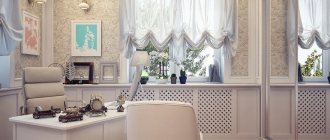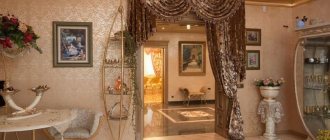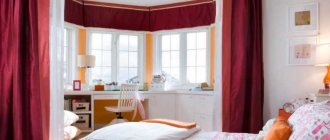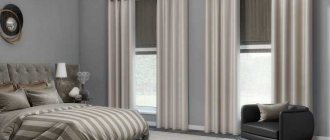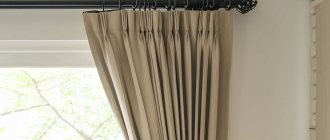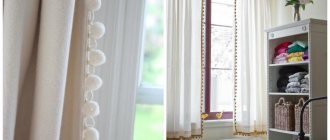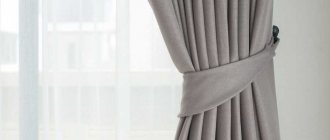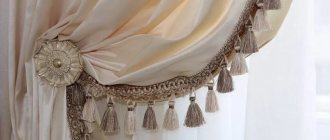You can complement your interior decor with accessories for window openings. Most people prefer curtains and blinds. But today, curtain tassels are especially popular. They can be purchased ready-made, or you can make them yourself. Such hand-made products will bring originality, freshness and create an exclusive style for the room.
Textile decorative elements for window openings are very diverse.
Decorating with brushes has a rich history dating back to the distant past.
What are curtain tassels
The use of tassels for curtains began in the days of Ancient Rome. In its simplest form, it is a bundle of threads tied with ribbon or braid. The widespread use of tassels as a decorative element began in the 18th century. With their help, not only curtains were finished, but also clothes, furniture, and shoes. The range of materials from which brushes were made has also expanded significantly. The most popular were silk, wool, and cotton accessories.
Decorating with brushes has a rich history dating back to the distant past.
Additional Information. Tassels look especially impressive against the backdrop of solid curtains made of heavy fabrics. If the design of the room tends towards minimalism, and the window opening is covered with a translucent curtain, then the use of tassels in the decoration will not be entirely appropriate.
The appearance of decorative tassels for curtains dates back to the Roman Empire, and they became extremely popular in France during the Renaissance.
Conclusion
When choosing suitable brushes or decorative tiebacks based on them, do not forget about the functional purpose of the room. No one forbids the use of such decorative elements in the kitchen, but they must be made of practical materials and not oversaturated with details.
Elements that perform only a decorative function should not be used for tying curtains that are constantly collected and unraveled. In all other cases, brushes do not cause much trouble, bringing only aesthetic pleasure.
Varieties
Depending on the place and method of attachment, the brushes can:
- fixed directly on the canvas;
- sew evenly along the edge of the curtain, creating an original edging;
- used as grabs.
The last option is especially popular today. Modern designers very often use tassels for curtains. With their help, curtains are finished both in small apartments and in huge halls for holding public events. Very often they are fixed using magnetic latches, which is very convenient and practical. In some cases, decorative brushes are additionally decorated with beads, plastic, glass and metal elements.
The decorative item is intended for decorating lambrequins and curtains. An accessory can also be a self-sufficient element in the design of a room.
Additional Information. In ancient times, in rich houses, brushes were decorated with semi-precious and precious stones, emphasizing the status and wealth of the owner.
Decor selection
Fringe is a type of decorative braid with laces, threads or any other pendants hanging from one side.
Traditionally it is sewn onto the bottom edge of curtains. But recently it has become fashionable to deviate from tradition, and more and more often you can find curtain models with fringes sewn at 2/3 of their height or with stripes at the same distance from each other. It can be colored or plain, natural or synthetic.
The braid (base) can also be very different - from a simple thick ribbon to openwork lace. To decorate curtains, 4 types of fringe are used:
- 1 Split - with an evenly cut straight edge.
- 2 Tinsel - with fluffed or twisted decorative threads.
- 3 Block - consisting of colored segments. They can be made in different shades of the same color scheme or contrasting ones.
- 4 Fan - with textured edges cut in the shape of a wave or scallops. Its base can also be figured - wavy or cascading.
The photo shows options for finishing fringed curtains with a rigid lambrequin.
In addition to fabric threads and strands, there are a huge number of elements that make up fringe: threads made of beads and glass beads or any other metal, wooden or plastic fittings, as well as tassels, bells and pompoms
How to choose the right brushes
When choosing decorative tassels for curtains, there are several factors to consider. First of all, you need to start from the accents that the brushes should highlight. Their use is justified if necessary:
- make a plain curtain brighter and more noticeable;
- beautifully fix the folds on the curtain;
- stretch the canvas, making its lower part heavier;
- highlight the texture of the fabric used;
- fix the heavy curtain.
In modern design, decoration with such accessories is possible in various styles, but they are more harmoniously combined with the classics - Art Deco or Baroque.
The safest option is to use brushes of the same tone as the curtain. This allows you to create a single image of window design. The use of tassels on curtains and decorative pillows fits very well into the design of a bedroom or living room.
The interior contains notes of luxury and elegance, and the use of tassels will become a symbol of wealth and noble status.
Where is it used?
Most often, fringe is used to decorate lambrequins , but nowadays it can also be used as an independent element, sewn horizontally, and in some cases vertically.
With its help, curtains are given a sophisticated and elegant look. Quite often, the accessory is used to decorate curtains in a classic interior, but options are also possible. Due to the fact that the main purpose of using fringe is to decorate the room, this element does not carry any functional load.
Using this type of braid for decoration, you can achieve visual highlighting and highlighting of individual parts of the interior, giving them a beautiful and elegant look.
Voluminous curtains made of velvet or silk will be ideally emphasized by correctly selected decor.
Color is also of no small importance; using a contrasting or monochromatic option will impose a certain shade on the entire room as a whole.
It all depends on what you want to achieve - the softness of bed colors or the pomp of crimson.
How to make curtain tassels with your own hands
If desired, you can make original tassels for curtains yourself. There are several ways to create brushes of different sizes. One of the most common is the method using a wooden ball. Its diameter is selected depending on the size of the brush we want to get.
Making a brush with your own hands is not difficult. It can be made from the simplest materials that you can always find at home.
A through diametrical hole is drilled in the ball, through which it is completely braided with thread of the selected color. A wooden or plastic ring, also braided with thread, is glued to the ball above the hole. This is the top part of the brush.
To obtain the lower part (skirt), you need to wind pre-selected threads (can be of different colors) onto a cardboard rectangle, the height of which is twice the diameter of the ball. The thicker the winding, the more fluffy the skirt will be. After removing the cardboard, the upper part is pulled together with braid, and the lower part is cut with scissors.
Purchased models all look the same, but a hand-made brush will be unique.
At the final stage, you need to connect the ball and the skirt. To do this, the braid with the upper edge of the skirt is pulled through the hole in the ball and secured with a cord. Additionally, you can decorate the resulting accessory with beads or multi-colored crumbs.
Additional Information. If desired, you can simplify the process of making a brush (without a ball and ring). To do this, the yarn is wound on a cardboard base, the lower part is cut, and a brush head is formed in the upper part, tightly tying the skein at a distance of about 1 cm from the edge.
Such decorative accessories are presented in various designs, for example, they can vary depending on thickness, shape, color palette, texture.
Homemade production
It’s not always possible to choose an option in a store that perfectly suits your style, and the prices for these accessories can be intimidating. Fortunately, tassels that can be used to beautifully tie curtains can be made by any housewife with at least basic needle and thread skills.
A good option for this are special blanks sold in stores, but if you wish, you can make very beautiful decorative items entirely from improvised materials. Moreover, for this you do not need any equipment or expensive materials - just a good imagination and desire.
Using a workpiece
The blank is a ball with a hole in the center , most often made of wood. There are both large options for brushes, which are used to decorate tiebacks, and small ones, suitable for creating many small tassels. To work you will need:
sheet of cardboard;- scissors;
- needle;
- threads of the colors you need;
- in fact, the brush blank itself;
- cord or piece of rope;
- glue;
Rules for using curtain tassels
Designers advise following several rules when using brushes:
- Brushes look impressive on simple plain curtains, becoming the highlight of the window opening design.
- If the curtain itself looks beautiful and rich, then it is absolutely not necessary to use additional decorative elements. They can create the effect of clutter and bad taste.
- Curtain tassels should not be placed lower than 100 cm from the floor.
- If the tiebacks are on symmetrical curtains of one window, then it is extremely important that the tassels are at the same height.
When decorating a window, not only the appearance of the brushes is important, but also how they are tied. The most common option is to attach a double cord to the head of the brush, which will cover the curtain, and attach it to a clamp on the wall. In this case, the latch itself (hook) can, depending on the design, either be hidden under the curtain or left in plain sight. The double knot connecting two brushes also looks very original.
Textile decorative elements will help create a unique design and add a sophisticated touch to any room.
Design options
Brushes are mainly used to decorate lambrequins or curtain ties, although they can become a self-sufficient interior decoration. For example, there are tassels decorating the cushions on the sofa that complement the curtains.
The color can be any - to match the canvas or contrasting. Golden beige tassels look great against a dark blue or brown background. On light beige curtains, black or bright decorations that repeat the interior colors look organic. To tie up curtains in delicate pastel colors, twisted cords (garters for curtains) with tassels at the ends, painted in metallic colors, are suitable as tiebacks.
Pros and cons of using curtain tassels in the interior
Most often, decorative tassels for curtains are used when decorating a bedroom or living room. Their use allows:
- make the room more comfortable;
- create a unique design and atmosphere in the room, especially if the brushes are made by yourself;
- give the room a touch of aristocracy;
- focus attention on the curtain, making it a key element of the interior.
It should be remembered that brushes were originally conceived as an element of the classical style. Today, the range of their applications is much wider; they are even trying to fit them into high-tech. But it is very important to capture a sense of proportion so that the brushes do not fall out of the overall concept of the room.
They must be selected based on the color palette of the interior.
A huge assortment of ready-made brushes and ideas for making them yourself allows you to choose brushes for almost any interior. However, their choice requires a serious, thoughtful approach. Therefore, if you are not 100% sure that the use of brushes will be in harmony with the overall interior, then you should not rush. It is possible that metal or plastic clamps would be more appropriate in this case.
An unusual design will bring refined, elegant and luxurious notes to the interior, showing the status of the apartment owners and their impeccable taste.
Silk threads
The silky shine of the fringe will give the room a unique, cozy, festive atmosphere. It is used both for edging the edges of fabrics and for making curtain ties.
You can buy natural silk threads separately, and then crochet a lace ribbon from them yourself. Such a decoration can become a masterpiece of handicraft, a real family heirloom.
Styles
Decorating curtains with fringe is typical for different styles, but you can especially often find it in classic and oriental interiors. Metallic braid fits perfectly with chromed metal cornices in high-tech style.
Curtains in Country style are often decorated with lace fringe made of cotton, and in a nursery, ribbons with plastic fish or shells in sea green color or with bells would be appropriate.
Fringe decor is possible in different styles:
